
The following article by Sardar Sunder Singh Ramgarhia, a descendent of Maharaja Jassa Singh Ramgarhia was first published in 1902 at Amritsar
ANNALS OF THE RAMGARHIA SARDARS
Introduction
It is from
the first decade of the eighteenth century that we take up the thread of our narrative.
Guru Gobind Singh having established the Brotherhood of Lions (the Singhs) had
gone back to Heaven leaving the infant Khalsa surrounded by blood - thirsty foes.
He had promised to lend a helping and guiding hand from above. But the helpless
children of the faith, seeing no visible hand to support them, trusted all their
welfare to the leadership of Banda Bahadur. Upon this great leader and warrior
the Guru had bestowed his blessings, and had received in return many sacred pledges,
Banda promising to abide by the Guru's injunctions. He proved a good nurse to
the young Lion - Cubs and avenged the murder of the two younger sons of the Guru
who were mercilessly killed at Sirhind by the tyrant Mughal (Nawab Wazir Khan).
The infant Khalsa soon grew to boyhood and learnt the use of its limbs. It was
at this time that the following twelve Misls (confederacies) were formed.
(1)
First and the greatest the Bhangi Misl ruled over a vast tract, the revenues of
which were a little over a crore of Rupees. The Misl had 12,000 horsemen.
(2)
The Ramgarhia Misl, exercised absolute sway over territories the maximum revenue
of which was between four and five millions of Rupees. The Misl possessed 360
forts and an army of 10,000 horsemen. Many Rajas and Nawabs paid tribute to it.
(3)
Kanhaiya Misl, had 8,000 fighting men.
(4) Ahluwalia Misl, the Raja of Kapurthala
is its present representative.
(5) Phul Misl, the three ruling Chiefs of Patiala,
Nabha and Jind are the descendants of this Misl and rule under British protection
over territories conquered by their ancestors.
(6) Sukarchakian Misl, from
this Misl rose the Great Maharaja Ranjit Singh, the Lion of the Punjab, who conquered
many of the Misls.
(7) Karoria Misl, had 12,000 fighting men.
(8) Daleywalian
Misl, had 7,500 fighting men.
(9) Nishanawalian (Banner bearer) Misl, had 12,000
followers.
(10) Fayzulapurian Misl, its descendants are still great Sardars.
(11)
Shahidan (Martyrs) Misl, had 2,000 horsemen.
(12) Nakaian Misl, had 2,000 horsemen.
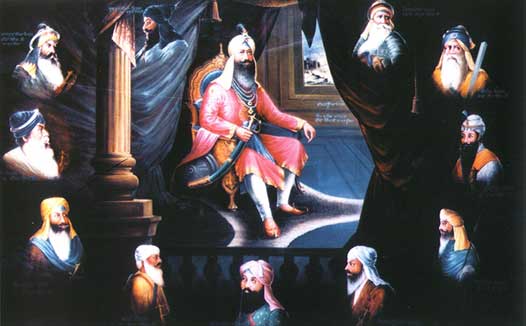
Maharaja Jassa Singh with contemporary Misl Sardars
Rome was not built in a day. So the organisation of the Sikh power in the sacred land of the five rivers was not the work of one man (the Lion of the Punjab) only, nor was it attained in one day. It was the result of the constant and combined efforts of the twelve Misls. The leaders of these Misls had to undergo and face many hardships, not only to establish the Sikh power in the Punjab but also to defend their faith and their very existence upon the face of the earth. The seed was sown and watered by the blood of the martyrs. Our nerves tingle and our brains throb when we read the stories of these heroes. No religion can be proud of so many martyrs. But it was Ranjit Singh only who was destined to reap the main harvest which had taken nearly a century to ripen and had cost the blood of the dearest sons of the Guru. By some means or other he reduced all the chiefs to subjection who were on this side of the Satluj. The Cis - Satluj chiefs obtained the protection of the British and thus escaped destruction. The reader will find in the following pages how sudden and extraordinary were the circumstances that changed the fate of the Ramgarhia family. Had it time to appeal to the British Government, this family also would have been ruling over its possessions like its contemporaries of Patiala, Nabha, Jind and Kapurthala. Reader! It is really very pathetic to compare the present condition of the family with its past grandeur. Time has changed, new men have come to the front, some no doubt pushed forward merely by fortune and others drawn to the front by the extended hands of appreciation. Let us thank the Almighty that we are under the benign rule of a government which has the best regard for, appreciation of, noble blood and high birth, of which the recent establishment of the Imperial Cadet Corps by our worthy Viceroy Lord Curzon, bears ample testimony.
Maharaja Jassa Singh Ramgarhia
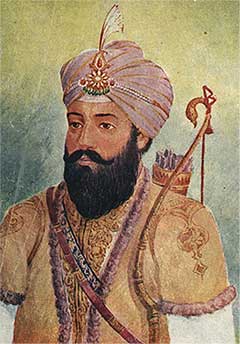
A
painting by artist S. Thakur Singh
ieh
auh blI sUrmW bWkw ijn sB dyS invwieAw,
pUrb p`Cm au`qr d`Kx kOm dw nW cmkwieAw
[
rwmgVHIAw kOm dw bwnI, is`K pMQ dw XoDw,
'swrMg' ijn is`KI dw JMfw lwl
ikly lihrwieAw [
Of the leaders of the Ramgarhia Misl during the earliest period of its existence Sardar Jassa Singh was the most distinguished, although he can hardly be called its founder. Through many eventful years the Misl had existed as an organised body under Sardar Khushal Singh.
Har Dass, the grandfather of Sardar Jassa Singh, was a resident of Sur - Singh, a large village in the Lahore district. He took Pahul (the Sikh baptism) from the hands of Guru Gobind Singh Ji himself and leaving the plough became one of his personal attendants. After the death of the Guru he joined the following of the Banda and took part in almost every religious battle under his flag against the Mughal Empire. In 1716 AD., he died in a skirmish. After him his son Sardar Bhagwan Singh became the head of the family, and with 200 followers entered the Imperial forces under the Governor of Lahore. Owing to his ability he rose to be a distinguished officer. He died fighting for his master in 1739 at Lahore, when Nadar Shah invaded India and the Governor resisted him ineffectually. He had five sons. Sardar Jassa Singh, the eldest, now became the head of the family. He was appointed a Risaldar by the Imperial Governor of Lahore, and the following villages were given to him in jagir Valla, Verka, Sultanwind, Tung and Chabba (all of these are now in the Amritsar district). On the death of Khan Bahadur, the Governor of Lahore, in 1746, Sardar Jassa Singh, together with his followers, joined his Sikh brethren at Amritsar.

At this time the celebrated Adina Beg, the Imperial Governor of the Jullundur Doab, exercised great influence in the Punjab. As there was constant quarrelling between him and the Sikhs, Sardar Jassa Singh was sent to him as their ambassador by the Sikhs, who considered the Sardar one of the ablest men among themselves. From all accounts Sardar Jassa Singh was a tall handsome young man, possessing rare intellectual qualities. The Nawab was so pleased with him that he granted all the demands of the Sikhs, to plead for which Sardar Jassa Singh had been sent. Moreover, Adina Beg took him and his brothers into his service and made him the Tahsildar over a large district. He remained for a long time in the service of the Nawab.
When Prince Timur, son of Ahmad Shah, marched against Adina Beg, the latter retreated towards the hills to the north and Sardar Jassa Singh and his brothers left him and went to Amritsar, where they joined the forces of Nand Singh Sanghania. The younger brother of Sardar Jassa Singh was at this time killed in action with the Afghans near Majitha. After the terrible blow dealt to the Sikhs by Ahmad Shah, in the Battle of Ghalu Ghara, in which 17,000 Sikhs fell, the three brothers, Jassa Singh, Mali Singh and Tara Singh, with Jai Singh Kanhaiya, were reduced to the necessity of hiding in jungles and subsisting on whatever chance threw in their way. They had, however, the temerity to visit Amritsar to bathe in the sacred tank, and pillaged the suburbs of the city. When attacked by the Shah's troops they fired off their matchlocks and fled to the jungles. After the departure of Ahmad Shah, Jassa Singh with his brothers Mali Singh and Tara Singh, and Jai Singh Kanhaiya emerged from their jungle retreat, and collecting their followers ravaged the country far and wide, building forts and establishing military outposts. When Khawaja Obed, the Governor of Lahore, attacked the Sikh fort at Gujranwala, he was opposed by the united forces of the Ramgarhias and Kanhaiyas and the guns, ammunition and treasure left by the Governor were equally divided by the leaders of the two Misls.
The Afghan prince and his guardian, seeing that all their attempts to disperse the Sikhs had failed, and that the number of the insurgents was daily increasing by thousands, and realising that the forces at their own disposal, however well armed and disciplined, were not strong enough to stand before them, considered it prudent to evacuate Lahore and retire towards the Chenab. They retreated in the night, unknown even to their own Hindustani troops, whom they distrusted, and in such haste that the royal family fell into the hands of the enemy, though they were subsequently released. This took place about the middle of 1758. The triumphant Sikhs occupied Lahore under their celebrated leaders, Sardar Jassa Singh Ahluwalia and the Ramgarhia Sardar of that name. Thus the Sikhs became for the first time matters of Lahore.
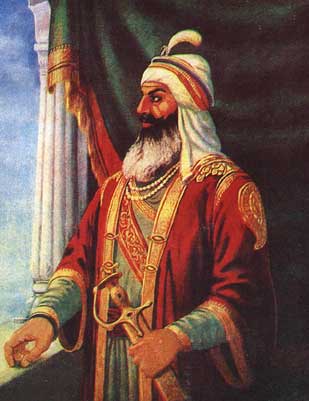
On the departure of Ahmad Shah from India in 1757 and the return of Adina Beg Khan from his hill retreat, the latter made a vow to extirpate the Sikhs who had become very troublesome, making common cause against Mussalmans. The Marhattas, who at this time swept over the Punjab, elevated Adina Beg Khan to the Viceroyalty of Lahore. The new Viceroy after reducing Kutab Shah, the Rohilla chief, laid siege to Batala and captured it. Mir Aziz Bakhsh, in command of a strong body of cavalry, was sent to Majha country with orders to attack and chastise the Sikhs wherever they could be found. Four thousand pioneers accompanied the Mir with sharpened tools for the purpose of clearing the jungle where the Sikhs had concealed themselves. Thousands of Sikhs were hunted down and mercilessly butchered. Some of them fled to Amritsar. This town was at this time nothing more than a large village and Sardar Jassa Singh partially fortified it surrounding a portion with a high mud wall, which they called Ram Rouni. Sardar Jassa Singh and his friends, on besieged here, fought gallantly, and made more than one sally from the fort; but they were overmatched and at length abandoned it at night, and their way through the enemy with considerable loss. The Ram Rouni was dismantled, but Adina Beg died shortly afterwards, and Jassa Singh taking command of the confederacy, rebuilt the fort he had defended so bravely, named it Ramgarh and his Misl the Ramgarhia. He sized at this time, aided by the Kanhaiya Misl, a wide tract comprising Dinanager, Batala, Kalanour, Siri Hargovindpur, Kadinan, Ghumman and many other places in Amritsar and Gurdaspur districts. The revenue of the possessions was estimated at from 6 to 10 lacs of rupees. Besides this Sardar Jassa Singh, who was the sole lord of the territory, acquired many villages in the Jullundur Doab. He also attacked and subdued the Rajas of Jaswal, Anarpur, Dipalpur, Chumba, Haripur and Katoch, and got a promise of 3 lacs of Rupees as an annual tribute from them, and built a fort at Harnala on the banks of Ravi and put his brother Mali Singh with 4,000 horsemen in charge for it. To his other brothers he gave separate jagirs.
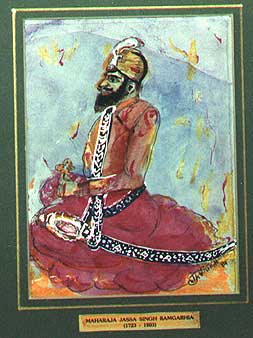
In 1761 when the war, which culminated in the battle of Panipat was going on between Marhattas and Afghans, all the Sikh Sardars taking advantage of the opportunity joined together and marched against Lahore. Amir Muhammad Khan, the Naib-Subedar, shut himself up in the city. The Sikhs surrounded the town on all sides and demanded a heavy sum of money for Karah Parshad. Rs 30.000 were offered to them, which they accepted and raised the siege.
The young Afghan prince and his Wazir Jahan Khan now devoted their attention to checking the increasing audacity of the Sikhs. Their stronghold at Amritsar called the Ram Rouni was attacked and levelled to the ground; the sacred reservoir (in which stands the Golden Temple) was filled up and all their places of worship were defiled. This outrage on the sacred City of the Khalsa roused the whole Sikh nation, and they assembled in great force, determined to defend their religion with the sword. They ravaged the whole country around Lahore, which simply swarmed with Sikh horsemen. Jahan Khan came out against them and succeeded at first in dispersing them. The Sikhs, however, assembled in larger numbers, and were now strong not only to cut off communication between the fort and the country, but also to collect the revenues of the area around Lahore and dispose of it as they liked. The matter came to a head when the Pathans were strong enough to offer battle again. A very severe fight took place, a great number of Pathans fell and the rest fled. The sacred tank of Amritsar, which had them filled up by Timur Shah, was again cleared out and the task of taking out the rubbish and filth from the sacred pool was forced upon the Afghans. In 1763 after Ahmed Shah had retired from the Punjab having totally defeated the Sikhs near Ludhiana and destroyed the holy temples at Amritsar, Sardar Jassa Singh Ramgarhia, in alliance with Sardar Jassa Singh Ahluwalia and Hari Singh Bhangi, attacked the Pathan town of Kassur, which they captured and sacked after a month's siege. Sardar Jassa Singh was with the Sikhs in the great battle of Sirhind in which Zen Khan was defeated and slain, and got many horses and camels as his share of the loot. Kutab Khan, who was sent by Mughal Emperor with 20,000 troops to punish the Sikhs, was defeated and slain by them at Phillour. The Sikhs plundered his camp. Sardar Jassa Singh among many other things got 150 horses and one elephant.
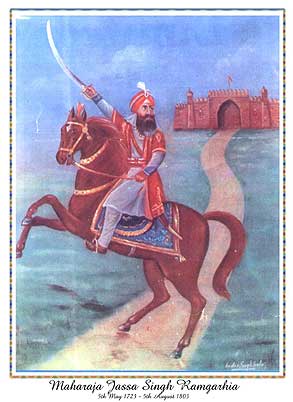
One of the main causes of the inability of Khalsa leaders to derive enduring benefit from their military power was mutual jealousy. There was a bitter feud between the two most powerful families, viz., the Ramgarhia and the Ahluwalia because the territories of the two Misls were contiguous, and also for the following reason. All the Sikhs forces on one occasion joined together and with a united army 60 or 70 thousand strong marched against Delhi. The Mughal Empire was at its last gasp and so no one opposed them. The Sikhs plundered the city, and burnt a great part of it. Sardar Jassa Singh Ramgarhia as well as Ahluwalia and many other Sardars penetrated into the Fort. Here some of the followers of Sardar Jassa Singh Ahluwalia made him sit on the imperial throne and proclaimed him king. Sardar Jassa Singh Ramgarhia, and many other Sardars who did not consider themselves in any way inferior to him, were very much annoyed by this action. Sardar Jassa Singh Ramgarhia, with many other things brought a piece of stone (length 6ft. 3 inches, breadth 4ft. 6 inches, thickness 9 inches) upon which the king used to sit and which was used as a sort of coronation stone. It was the identical slab on which the Ahluwalia chief had been made to sit and proclaimed king. The historic stone was afterwards sat in the front part of the Ramgarhia Bunga where it still exists. Sardar Jassa Singh Ramgarhia's vow is fulfilled, because it is used as a throne for the Holy Granth Sahib, the everlasting guide and the immortal king of the Khalsa nation.
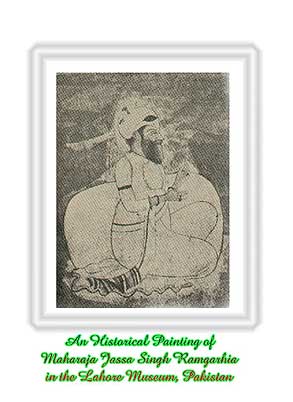
Once upon a time Sardar Jassa Singh Ahluwalia was passing near Gurdaspur on his way to Achal, he was attacked by Sardar Khushal Singh, Mali Singh, and Tara Singh, younger brothers of Sardar Jassa Singh Ramgarhia. His troops were dispersed and he was taken prisoner.
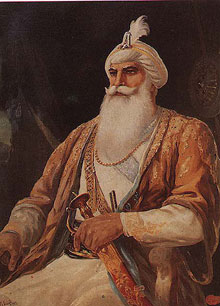
S. Jassa Singh Ahluwalia
The Ramgarhia chief, however, released him with rich gifts when he was brought before him as a prisoner for the old Sikh barons had much of the spirit of chivalry in them. But the Ahluwalia chieftain swore a mighty oath that he would never take off his turban till he had not seized all the Ramgarhia estates. Many chiefs came to help him, incited by the prospect of plundering a new jagir. There were Ganda Singh and Jhanda Singh Bhangis, the Kanhaiya Sardar Jai Singh and Hakikat Singh, old friends of the Ramgarhias, Sardar Charat Singh (grandfather of the Maharaja Ranjit Singh), Nahar Singh Chamiariwala and many others. They attacked Sardar Jassa Singh Ramgarhia on all sides while no one came to his assistance. There were only ten thousand horsemen in his service. He held on for four years against the combined forces of the opponents; his brother Sardar Tara Singh was killed in action, Sardar Khushal Singh another brother was severely wounded. There were left only four thousand horsemen, the rest having been killed. So, he had to leave the Punjab. Crossing the Sutlej he overran the country with his horsemen and marched up to the walls of Muthra and Agra. On one occasion he penetrated into Delhi itself, and after plundering and burning the Mughal Mahalla, went into the Fort and carried off 4 pieces of cannon and many other things from the Mughal quarter. Passing through Panipat and Karnal he attacked the Nawab of Meerut, and after defeating him got a promise ten thousand rupees per annum as tribute. He also received large presents from the Rajas of Bharatpur and Dholpur. The Maharaja of Jaipur's attitude was also cordial towards him, and he received many presents from that prince. Among these was a Gupti (swordstick) which is still in the possession of the family. The name of the Maharaja is engraved upon it in golden letters in Persian characters.
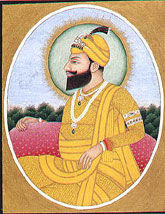
At this time there arose a quarrel between Raja Amar Singh of Patiala(above) and the Nawab of Patodi and several other chiefs. The Raja called Sardar Jassa Singh Ramgarhia to his assistance. The Sardar at once proceeded there and defeated the enemies of the Raja. He took many villages on the banks of Jumna. The following chiefs, combined together, opposed him here: Sher Singh of Buria, Gurdit Singh Ladowal, Baghel Singh of Salodi, Gurbakhsh Singh of Umballa. A very severe struggle was the result, in which ultimately Sardar Jassa Singh proved victorious and received valuable peace - offerings from each of these chiefs. The following instance will show that, in spite of the hardening effects of constant warfare, the Sardar was a Knight-errant always at heart to "poise his lance" on behalf of the victims of tyranny and oppression. One day a Brahman complained to him that the Governor of Hissar had carried off his two daughters by force. Sardar Jassa Singh at once marched against the place, which he took and sacked. He slew the Nawab with his own hands and restored the girls to their father. Fearing lest the local Brahmans in their blind bigotry might outcaste the girls, the Sardar collected all the Brahmans of the district and obliged them to take food from the hands of the girls. Having put Saadat Ali Khan, the son of the deceased Nawab, on the guddee he got Rs. 50,000 from him as peshkash and the same amount from the inhabitants of the city as Nazrana. Thus he moved about for five years in Rajputana and N.W.P., shedding lustre on the Khalsa arms by his prowess and martial achievements. He was at times reduced to great straits. At Sirsa, for example, his troops asked for the payment of the arrears of their pay, but the Sardar had not money enough for the purpose. In his sore need he devoutly prayed for help from Above. And most providentially he obtained the means to get out of his trouble. It so happened that a servant of the Sardar dropped his vessel into a well. A diver was sent down to recover it, and he discovered at the bottom four boxes, full of gold Mohurs, to the value of five lac rupees. The Sardar thanked the timeless being fervently for bestowing on him such a gift at such a critical moment, which not only enabled him to pay his troops, but also to enlist more.
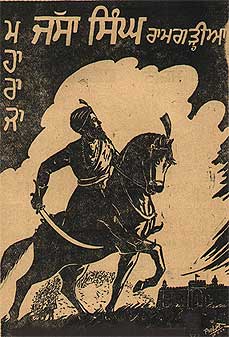
In
1783 Providence provided the opportunity for Sardar Jassa Singh's return to the
Punjab. There arose a quarrel between the Sukerchakian and the Kanhaiya Misls.
Being too weak to enter the field alone, against the forces of Kanhaiya and Bhangi
Misls, Sardar Mahan Singh, the head of the Sukerchakian (father of Maharaja Ranjit
Singh) cast about for an ally. He, therefore, made overtures of friendship to
Sardar Jassa Singh Ramgarhia who was universally considered on of the boldest
Sikh barons of the time. Envoys were immediately sent inviting him to return to
the Punjab. Sardar Jassa Singh Ramgarhia, in addition to being a brave soldier,
was also a farsighted statesman. He at once perceived what the consequences of
the proposed alliance would be. So he sent the following message to Sardar Mahan
Singh: "When Sardar Jai Singh subdued he is sure to have his granddaughter
betrothed to your son Ranjit Singh, also will give back the fort of Kangra to
Raja Sansar Chand, thus you will all become good friends again, and allied opponent
of mine. It is useless, therefore, to ask me to interfere in your matters."
On hearing this answer Sardar Mahan Singh and his friend Raja Sansar Chand of
Katauch and other hill Rajas again sent a message to Sardar Jassa Singh assuring
him that if he would help them against Sardar Jai Singh, they would never cease
to be his friends. Sardar Jassa Singh having satisfied himself as to the motive
underlying Sardar Mahan Singh's offer, and being convinced that it was sincere,
lost no time in returning to the Punjab with all the forces he could collect.
The combined forces of Sardar Mahan Singh and Sardar Jassa Singh Ramgarhia now
appeared suddenly with a few miles of Batala, the principal town of the Kanhaiya
territory. Sardar Jai Singh was now called upon to surrender the share of the
Ramgarhia possessions, which had been unfairly allotted to him, and on his refusal
the invaders proceeded to occupy and ravage the country. Sardar Jai Singh mustered
his Misl and placing his son Gurbakhsh Singh at the head of 8,000 horsemen sent
him to expel the invaders. A desperate engagement ensued, in which Gurbakhsh Singh
exposed himself with the rashness of youth, and was shot dead by Sardar Jassa
Singh's arrow. On hearing the death of his son Sardar Jassa Singh dismounted from
his horse, and emptying his quiver at the enemy exposed himself to their fire.
The Ramgarhia's, even though flushed with even though flushed with victory, respected the grief of the Sardar for the death of his brave son, and drew their forces off with a view to seizing Riarki. Jai Singh returning to Batala, erected a tomb on the northern side of the city near a nullah over the remains of his son. Being hard pressed by Sardar Jassa Singh he was compelled to leave Batala. The city being taken possession of by the Ramgarhias, Soiyan was now the only place that remained in the hands of Sardar Jai Singh, who began to plunder the possessions of the Kanhaiya Misl on the banks of Bias. Misfortune never comes alone; Sardar Jai Singh was threatened from another quarter. Sansar Chand, the hill chief of Katauch, bore enmity towards Sardar Jai Singh on account of the latter having taken his fort of Kot Kangra. He came down as far as Hajipur, seizing all the country between that place and the hills, including Mukerian. Sardar Jai Singh was now anxious to make peace with Raja Sansar Chand and Sardar Mahan Singh, and in order to secure it he gave up Kot Kangra to Sansar Chand who promised (against his promise with Sardar Jassa Singh Ramgarhia) to help him against the Ramgarhias, and restored to Sardar Jassa Singh Ramgarhia his old possession, while to cement his friendship with Mahan Singh, he betrothed Mehtab Kaur, the daughter of his deceased son, to the youthful Ranjit Singh, afterwards known as the "Lion of the Punjab." The betrothal took place in 1785 and the marriage at the close of the following year. Having accomplished this important object Sardar Jai Singh, being joined by the Rajas of Nurpur and Chamba as well as Sansar Chand, and Sardar Mahan Singh marched against Batala. Sardar Jassa Singh was in the city, prepared for the siege, which was raised after being carried on for 20 days. Sardar Jassa Singh, as a measure of protection, resolved to surround Batala with a very high wall of bricks, but could only finish one side of it. Hence Sardar Jassa Singh was not destined to enjoy peace, and for many years he was engaged with varying success, in disputes with the Kanhaiya Misl, which had the aid of Sardar Mahan Singh and Raja Sansar Chand.
In 1796 took place his last and most severe struggle with the Kanhaiya Misl. Mai Sada Kaur, widow of Gurbakhsh Singh, was the head of the Misl and with her own forces, and those of her son-in-law Maharaja Ranjit Singh, the Lion of Punjab, and of others as Sardar Fateh Singh Ahluwalia son of Sardar Jassa Singh Ahluwalia, she besieged Sardar Jassa Singh in Miani fort on the banks of Bias in Hoshiarpur district. Sardar Jassa Singh defended himself for some time but his provisions ran short and he sent a message to Sahib Singh Bedi at Amritsar asking him to mediate between himself and his enemies. Sardar Jodh Singh Wazirabadia and Dul Singh Gil were with the Bedi as representatives of Ranjit Singh, when the Ramgarhia messenger arrived. Sahib Singh sent them with a message to Sada Kaur and Ranjit Singh bidding them to raise the siege of Miani. But Sada Kaur would not return without having had her revenge for her husband's death, and she knew that her enemy was now in her hands so no notice was taken of the Bedi's injunction. Again Sardar Jassa Singh sent a messenger to the Bedi, who sent word in reply that the Sardar's enemies would not mind him (the Bedi), but the Guru himself would help him. The messenger returned to Miani, and, wonderful to relate, that very night the river Bias came down in flood and swept away a large portion of the Kanhaiya camp, men, horses, and camels. Sada Kaur and Ranjit Singh escaped with difficulty and retired to Gujranwala.
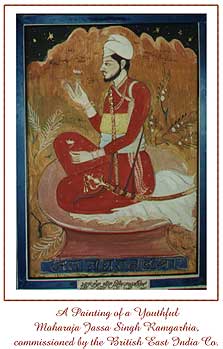
Sir Lepel Griffin writes in his Ranjit Singh (Rulers of India series): "by the bold and successful measure Ranjit Singh became possessed of the two Sikh capitals political and religious i.e., Lahore and Amritsar, and had little more to fear in his career of conquest. For the great Kanhaiya confederacy was already in his hands and the famous Ramgarhia baron Sardar Jassa Singh was old and feeble and Ranjit Singh knew that he had not long to wait before he should obtain his estates."
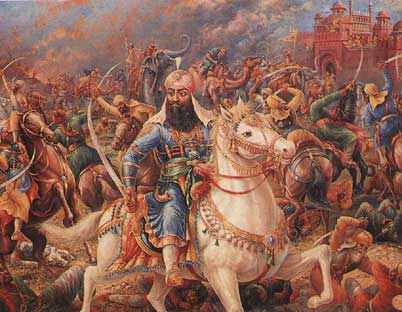
Conquering the Red Fort - Delhi
In 1800 a cabal was formed against Ranjit Singh who had captured Lahore in July of the proceeding year, and whose successes were beginning to fill all the Punjab chiefs with alarm. Besides others there were the following Sardars in it: Sardar Gurdit Singh and Sahib Singh Bhangi, Sardar Jodh Singh of Wazirabad, Nizam Din of Kasur, Sardar Jodh Singh Ramgarhia son of Sardar Jassa Singh Ramgarhia, who being too old could not come in person. The great Bhangi cannon (which is now placed at Lahore opposite the Municipal market) with many other pieces of cannon was also with them. Sardar Gulab Singh Bhangi was appointed to be their leader and commander. When they reached Bhuseen, which is situated towards the east of Lahore at a distance of 14 miles, they halted to wait for other Sardars who were coming to join them. They determined to attack with all their combined forces and to decide the fate of Ranjit Singh once and for all in a single decisive battle. Ranjit Singh heard of this at Lahore and was very much alarmed as he had not sufficient money to distribute to his forces and make them sacrifice their lives for him. A very old man aged ninety came to him and said that he could tell him about a treasury and also some pieces of cannon, which Mir-Muin-ul-Mulk had buried. Ranjit Singh as if got new life on hearing such happy news and flattered him. When the ground was dug he found a treasury of many lacs of rupees and also a few pieces of cannon. He at once fortified his castle and distributed large sums of money to his forces and marched from Lahore with all his forces and reached at a distance of one mile from the allied forces of his enemies. The hostilities lasted many months without any result. One day Sardar Gulab Singh called all the Sikh Sardars and said that they must fight a decisive battle on the morrow. All agreed with the proposal, but early next morning he did not appear in the field, and when some persons were sent to call him from his tent he was found dead in his bed, having drunk too much overnight. On his death many Sardars made friends with Ranjit Singh, while Sardar Jodh Singh and others went back to their respective territories. Thus did Ranjit Singh continue to be the Master of Lahore.
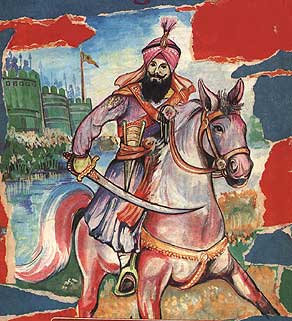
The nephew of Sardar Jassa Singh proved himself a worthy scion of the Ramgarhia family at this time. His name was Sardar Diwan Singh. One day he came to his uncle and complained about the shortness of his allowance and begged that it be increased. But Sardar Jassa Singh gave a very cold answer and said that now he was a young man and must make his own fortune in the world. The youthful Sardar at once left the house with a few horses and foot soldiers. Many adventurers knowing him to be the nephew of Sardar Jassa Singh Ramgarhia became his followers. Within a few short months he conquered a territory the annual revenue of which amounted to 1 lac of rupees and built himself a fort near Kadian, and named it Thakargarh. With a garrison of 1400 horsemen he fixed his residence in it. Sardar Jassa Singh was very much pleased to hear of the success of his nephew.
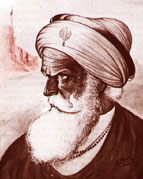
Sardar Jassa Singh Ramgarhia (above)died of fever not long after in the year 1803 AD The family is proud to still have his sword with his name engraved upon the hilt in golden letters and in Gurumukhi characters.
He was one of the bravest and noblest of Sikh barons of his time, and in many battles it was through his personal valour alone that the Sikhs became victorious. History tells us that it was principally through his help that the Bhangi Misl became so powerful in every respect. His own Misl was second to none except that of the Bhangi's, and so all historians place it second. Whoever sought his protection was given shelter. When Nawab Bhamboo Khan, brother of Ghulam Kadir, after assassinating Shah Alim the emperor of Delhi, took refuge with him, he gave him a jagir in Majha and kept him as his protege. Sardar Liaq Singh, captive in the hands of Maharaja Ranjit Singh, ran away and came to him, and he took him under his protection. He waged war for his sake with the Maharaja for 4 months, but did not give him up. Once the Emperor of Delhi sent him a khilat including among other things a tabar (halberd). The Sardar took only the weapon him self and distributed all the other things among his courtiers. This relic is still kept as heirloom in the family. He was one of the two chief personalities of the Khalsa nation; the only other name that can be placed along side of his is that of his illustrious namesake Sardar Jassa Singh Ahluwalia. These two great chiefs were unapproachable among Sikh leaders. As brilliant on the battlefield as on the council board, they were born to command and to lead.
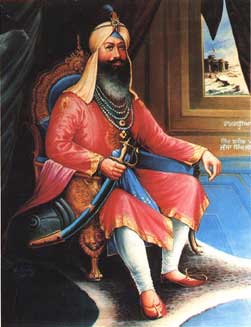
When he (Sardar Jassa Singh Ramgarhia [above]) was attacked by the Ahluwalia chieftain
and obliged to leave the Punjab it was because almost all the other Sikh Sardars
were owing to a spirit of jealousy and rivalry, leagued against him, and he displayed
a fertility of resource and indomitable pluck in those dark days that mark him
out as far and away the superior of all his contemporaries and adversaries in
the qualities of a born leader of men. Napoleon Bonaparte when he came back beaten
from the field of Waterloo declared that he was more proud of that defeat than
any of his victories. It requires no extraordinary power of imagination to realise
in all their grandeur the martial virtues of the man who single-handed stood for
four years against an enemy whose forces numbered seven times his own. According
to his lights to the standard of his time, he was also an orthodox Sikh, penetrated
with a sense of the transitoriness of the world. He took a leading part in every
fight for the faith. The Panth had the first place in his thoughts. It was his
habit to frequently repeat a poem, which he had himself composed. It is impossible
to convey its beauty and force in a translation, and its subjoined literal rendering
is not calculated to do justice to it. However, it is quoted below:
"There
is a time when we carry hawks (emblem of royalty) on our hands, and Dhaunsas (large
kettle drums) thunder at our doors. There is a time again when we are on foot
and carry loads upon our necks or shoulders.
"There is a time when we
have no appetite for the choicest delicacies."
"There is a time when
even a handful of wheat we cannot get."
"There is a time when we
have crowds of beggars at our doors."
"There is a time when we sit
as a supplicant at the door of others."
"Let us not then forget the
name of the Lord, nor lose heart, let us be content in whatever sate it pleaseth
God to keep."
It would be hard to match the above lines for the simple piety they breathe, the humble trust on High they inculcate, the spirit of manly self-reliance they infuse, the lesson of the transitoriness of the world they teach of fortune they portray and the sermon of contentment they preach.
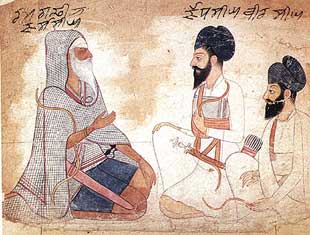
Maharaja Jassa Singh with his two sons Jodh Singh & Bir Singh (This portrait was probably commissioned by Maharaja Jassa Singh himself during 1780's. Maharaja was an accomplished architect and artist, as he had designed and erected many forts, no doubt he promoted ART in a very big way by sponsoring contemporary artists like Purkhu and Garba. B.N Goswamy pays a high tribute to the Maharaj in his book 'Piety & Splendour'.
Sardar Jodh Singh Ramgarhia
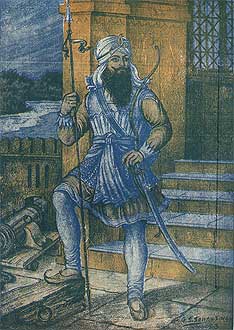
Sardar
Jodh Singh in the Fort of Miani
Sardar Jassa Singh was succeeded by his eldest son Sardar Jodh Singh Ramgarhia who, aided by Sansar Chand, the hill chieftain took back by force the following important towns from the Ahluwalia Misl: Garh, Depalpur, Bhunga, and Hoshiarpur. He gave after a time, Hoshiarpur in Jagir to Nawab Bhamboo Khan; to Muhar Singh, Hazura Singh and Thakar Singh, who were dismissed by Sardar Fateh Singh Ahluwalia, he gave five villages in Jagir. Sardar Fateh Singh Ahluwalia and Sardarni Baghel Singh collected a force of twenty thousand men and marched against Sardar Jodh Singh, who, aided by Nidhan Singh, came forth to meet the enemy. A great battle was fought at Banola, in which, however, Sardar Fateh Singh was worsted.
The following story which Sir Lepel Griffin by mistake has attributed to Sardar Jodh Singh Wazirabadia is really about Sardar Jodh Singh Ramgarhia, because it is found in the family records which were put together by the late Sardar Mangal Singh Ramgarhia C.S.I. "The Maharaja, thinking Sardar Jodh Singh too powerful to attack, invited him to Lahore on a friendly visit. Suspecting Ranjit Singh's intention he brought a large force with him, which he was asked to send back, a request which he was too proud to refuse compliance. He attended the Darbar next day with only twenty-five followers whom he left outside. He was received by the Maharaja with the utmost cordiality, but suddenly Ranjit Singh made a sign to his people to seize the Sardar. He, drawing his sword, called on them to come on as he would not be taken alive and had never learned to turn his back on an enemy. His courage so impressed the Maharaja that he dismissed the chief with honour, rich presents and an addition to his estates. So far the story is creditable to Ranjit Singh as well as to the Sardar, but when shortly afterwards Jodh Singh died leaving only infant sons, the Maharaja seized all his possessions."
When Holkar, at the head of a large Maratha force, came to the Punjab, he being invited by Sardar Fateh Singh Ahluwalia plundered and destroyed nearly 50 villages of Sardar Jodh Singh who at once sent two messengers named Ral Singh and Lakha Singh to Major Lake who was pursuing Holkar. The British commander received them with due formality and gave them robes of honour. He also sent a rifle and a field glass to the Sardar. Both of these are still preserved as an heirloom in the family. After this Sardar Jodh Singh entered into friendship with the Afghans of Kassur. Many times did Ranjit Singh attack his territory, but the Sardar with the help of Afghans always defeated him.
A compact of
eternal friendship between Ranjit Singh and the Ramgarhia family was drawn up
before the Granth in the Holy Darbar Sahib at Amritsar. Ranjit Singh stamped the
paper in his royal and illiterate way with his open palm dyed with saffron. The
better to inveigle Sardar Jodh Singh he went over to the Ramgarh fort almost unattended.
He professed his great admiration for the fortifications and ordered the foundation
of a fort, afterwards called Gobindgarh (which still exists at Amritsar to the
west of the city) to be laid down according to the same plan. The simple hearted
Sardar Jodh Singh was won over. He accompanied the Maharaja with all his forces
in the last successful expedition against Kutb-ud-din Khan. Mr. Prinsep writes
in his life of Maharaja Ranjit Singh:
"Ranjit Singh who was himself free-spoken
and allowed great latitude in conversation to his courtiers received at this period
a rebuke for the grasping disposition he displayed in his treatment of the old
Sikh Sardars from Jodh Singh Ramgarhia, himself a reduced chief of the class.
When taking his leave to join Muhkam Chand in the operations against the Faizulapurian
Sardars, Ranjit Singh offered him presents as a mark of a favour. He begged, however,
with characteristic frankness that such an honour might be dispensed with in his
case, for he should deem himself fortunate in these times if allowed to keep his
own turban on his head. Ranjit Singh took no offence at his freedom, but smiled
and told him to be faithful and of good cheer."
It was with his assistance as well as that of Sardar Fateh Singh Ahluwalia that the Maharaja could take Kangra and subdue Raja Sansar Chand. He also helped the Maharaja in Multan expedition. The Maharaja being pleased gave him many villages in jagir which were taken from Sardar Golab Singh Kharara, the revenue of which amounted to 25 thousand Rs. Per annum. In 1811 AD, he gave him in jagir 11 villages in Sheikhupura, and also one elephant, the revenue of these villages amounted to Rs. 12,000 per annum. He was much respected by the Maharaja who used to call him Baba-Ji and give him a seat next to him, whenever he used to go in the Darbar. The Sardar died in 1816. Like his father he was also brave and generous. Whoever sought his protection received it. He gave shelter to Sardar Gulab Singh Bhangi and also to Bibi Lashmi of Phagwara who were defeated by Ranjit Singh. It was he who built the great Ramgarhia Bunga, with its two lofty towers. He helped much in the building of the Golden Temple. He brought the pieces of perforated marble that serve as parapets on both side of the causeway that leads to the Temple situated in the centre of the tank, from the four minarets of the maqbara (tomb) of Jahangir situated near Shahdara on the bank of Ravi, close to Lahore the lower storeys of these minarets mosaic work and finely tessellated and chequered pieces of marble from Muhammaden monuments situated as far as Delhi and Agra. He also built the first two storeys of Baba Atal (the loftiest building in the city of Amritsar, the towers of his own Bunga being second in height). Thus he had the honour to build the finest and the loftiest edifices of Amritsar which constitute the integral part of the beauty of the city as a whole. The family still possesses a Khanda and a Katar of this brave man as an heirloom
The death of Sardar Jodh Singh was the signal for the breaking out of dissension in the family. Sardar Diwan Singh, Bir Singh, Mehtab Singh and widow of Sardar Jodh Singh all set up claims for the estate. The Maharaja, hearing of this, summoned them to Nadaun where he then was, promising to settle the dispute by arbitration. On their arrival they were received with courtesy by the Maharaja, but soon took occasion to leave the reception tent, which was straight away surrounded with troops and the three Ramgarhias were made prisoners. Then Ranjit Singh marched on towards Amritsar and after some severe fighting took the fort of Ramgarh. Again marching northward he seized the whole of the vast Ramgarhia jagirs and in a short time reduced all their forts. Thus was fulfilled the saffron bond! There was a proverb in the country that it would take a year to conquer the Ramgarhia family, if it lost one fort per day, because the family had 360 forts. But when fate was adverse, a few hours sufficed to change the state of the family. Sardar Wir Singh and Mahtab Singh were soon released and were placed under Sardar Lehna Singh of Majitha, a jagir of 45,000 was settled on the family. Sardar Diwan Singh for some time refused to accept his share of Rs. 12,000 and remained a prisoner, but at length pretended to acquiesce. On regaining his freedom, however, he fled to Patiala where he was well received by Maharaja Karam Singh and remained there for 10 months. Here many old retainers of the Ramgarhia clan came and assembled round him. When their number swelled to a thousand, the Rajas of Patiala, Nabha, and Jind suspected the Sardar to be a secret agent sent by the Maharaja to seize their territories, so they asked him to keep only four or five hundred men and dismiss the others. The Sardar not agreeing to the proposal took friendly leave of them and wandered about for some time. Afterwards, at the intercession of some Sardars, the Maharaja gave him jagir worth Rs. 97,000 per annum and sent him in command of 1,000 men to Baramoola cantonment in Kashmir, a difficult hill post on the road to Srinagar, which was on the frontier of the Maharaja's territory. Moreover, he was allowed, as a perquisite, to get shawls worth Rs. 7,000 annually from the Governor of Kashmir. In 1828 the Maharaja fell sick. The Sardar hearing of his illness at once came to Lahore with all his forces he had under him without any permission and even the information of the Maharaja. By chance the Maharaja recovered very soon. He understood very well the purpose of the Sardar's coming and took no offence of it, but pleased him with many rich gifts. The Sardar went back to Baramoola where he died in 1834 after remaining there for 14 years. His Sumadh together with a large Dharmsala is situated there on the banks of the River Jhelum. The house where the Sardar used to live was situated at a distance of few miles from Srinager, all signs of it have disappeared but the place is marked by some lofty popular trees and is still called cantonment of Sardar Diwan Singh Ramgarhia. Sardar Bir Singh had died 6 years before, i.e.,in 1828 when 2/3 of his jagirs were resumed.
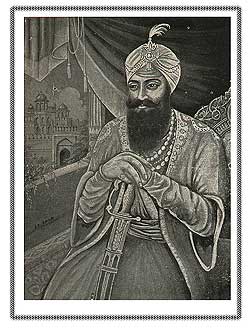
Maharaja
Jassa Singh Ramgarhia (above) played a significant role in the historic times
to liberate the Punjab from the yoke of the Moghal rulers. He was the most dazzling
star in the galaxy of the warriors of the 18th century.
After
Guru Gobind Singh (1708 AD) and the execution of Baba Banda Bahadur in 1716 AD
the Sikhs had to undergo great hardships, inhuman oppression and unspeakable atrocities
at the hands of the Moghul rulers of the country. It was a time of national crisis
for the Khalsa Panth when its very existence was challenged and thwarted, tenets
were defiled and the dangers were groping wide to gulp down the abyss of times.
Thus loomed large this period of uncertainty for the Panth.
Sardar Mangal Singh Ramgarhia
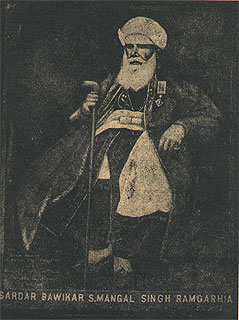
After the death of Sardar Diwan Singh, his son Sardar Mangal Singh became the representative of the family. He during his younger days served about the person of the Maharaja, who gave him jagirs in Dharamkot, Kalowal, Tibroh and Kadian worth Rs. 9,000 of which Rs. 3,600 personal and Rs. 4,500 pay. After his father's death Sardar Mangal Singh was sent to Peshawar in command of 400 foot and 110 sawaars of the old Ramgarhia clan. Here under Sardar Tej Singh and Sardar Hari Singh Nalwa, he did good service and fought in famous battle of Jamraud in April 1837, where the gallant Hari Singh was killed. In 1839 he was recalled and sent to the hill country between Beas and Sutlej under the orders of Sardar Lehna Singh and during the absence of that chief at Peshawar was placed in charge of the hill forts and was active in the suppression of the insurrection of 1840. He built many forts on the frontier according to the orders of the Maharaja. The great Ramgarhia Bunga (which with other forts and territory was taken by Ranjit Singh on the death of Sardar Jodh Singh) was given back to him as a special reward by the Maharaja, and so the Bunga became the property only of this branch of the family. After this he was appointed by the Maharaja to the responsible and coveted post (for which he was fitted) of collecting the tribute from the hill Rajas (the very chieftains who once used to pay tribute to his ancestors). He performed his duties to the entire satisfaction of the Maharaja for which he got many robes of honour and testimonials at different times from the Maharaja. Some of these documents are still with the family. There have been three great occasions for the English Government to test the loyalty of the Punjab inhabitants, specially the Sikhs. At each of these occasions Sardar Mangal Singh was the representative of the family and did his best for the English cause.
The First Sikh War
On
this occasion the Sardar was at Mandi appointed by the Sikh Government to collect
the tributes from the entire hill Rajas. He held in check the entire hill Rajas
and prevented their coming against the British. He garrisoned himself in the fort
of Cumlah, which commands all the hill roads. Unfortunately his two infant sons
(one was the late Sardar Gurdit Singh Ramgarhia and the other named Hardit Singh*
died very young) fell into the hands of the hill Rajas who were besieging the
fort. An incident is related of this seize which shows the chivalrous sense of
duty of this Sardar. The besiegers put the little ones in front of the attacking
line but the Sardar did not hesitate to fire saying thus he would not give up
his cause for the sake of his children, if he lived through it God would give
him more children. Providence rewarded him for his steadfastness and firmness.
The babies escaped unhurt! The Rajas, impressed by the determination of the Sardar,
and considering the fort too strong to be reduced by them, raised the siege. On
the memorable 9th of March 1846, a treaty was concluded between the English and
the Sikhs, and the Sardar received word from John Lawrence informing him of the
compact. The Sardar at once obeyed the order and vacated the fort. Sir Lepel Griffin
writes in the Punjab chiefs:
"The Rajput chiefs with Raja Balbir Sen of
Mandi at their head were not slow to take advantage of the war with the English
and gave the Sardar plenty of work, but he held his ground till the treaty of
9th March 1846, enabled him to give up his trust with honour."
*Many wonderful stories are told of this marvellous child. It would not he out of interest to relate one of them. While quite a child he used to ask the head Munshi of the family to supply him with slips of paper with names of different villages written on them. In his childish manner he used to sign them with his own hands and then to distribute them among the servants telling them if they presented these slips when he became of age these villages would he actually given to them.
Second
Anglo-Sikh War
The second occasion was the second Sikh war. At this
juncture the Sardar took upon himself the duty of guarding the communication between
the Amritsar and Gurdaspur district and captured the notorious rebel Hari Singh.
Sir Lepel Griffin records as follows:
"During the second Sikh war Sardar
Mangal Singh remained loyal and did excellent service in guarding the roads and
maintaining order in the Amritsar and Gurdaspur districts. His great exploit,
however, at this time was the capture of the notorious rebel and robber Hari Singh
who had for sometime kept the country about Amritsar in a state of alarm. This
he effected at Sagarpura near Rangar Nangal for which a grant of jagir worth Rs.
3,700 was made to him by the Darbar and confirmed after the annexation."
For this service he also got a khilat and the following things from the English
Government:-
Sword: (still with the family), one Gold bracelet: one
Horse:
one
Shawl Cashmere: one
The third occasion was mutiny. At this occasion the Sardar raised 20 sawaars according to the order of the Government. Himself being too old to go in the field in person, he sent his eldest son Sardar Gurdit Singh Ramgarhia who joined Colonel Abbot at Hoshiarpur and served to the entire satisfaction of his officers. According to the orders of Captain Harnas, Assistant Resident, Lahore, Sardar Mangal Singh joined the forces of General Havelock.
In
1862 on the retirement of Sardar Jodh Singh, he was appointed Manager of the affairs
of the Sikh Temple at Amritsar. The Sardar with tact and ability, as will be seen
from the testimonials filled the appointment, which was one of some difficulty.
In the same year he was appointed an honorary Magistrate of the city at Amritsar.
In 1864 the title of Sardar Ba-Wikar (Sardar with honour) was conferred upon him.
In 1876, His Royal Highness the Prince of Wales was graciously pleased to confer
upon him the Companion-ship of the Star of India and adorned the breast of the
Sardar with the Star with his own royal hands on the platform of the Clock Tower
at the time of the visit to the Temple. He was also presented to his Royal Highness
in the Levee at Lahore. He died in 1879. Sir Lepel Griffin writes of him:
"Sardar Mangal Singh was a man of education and liberal ideas. It was in
a great measure owing to his influence and example that the case of Female Education
has been so widely and systematically taken up in the city of Amritsar."
He took interest in the University movement. He used to take great part in all
public movements. As an Honorary Magistrate he performed his duties so well, that
he received the thanks of the Government of India for it. He died in 1879 nearly
at the age of 80 years. The family has the pride of still possessing his sword
with his name written upon the hilt in golden letters in Gurmukhi character. He
remained the Manager of the Golden Temple for 17 years from 1862 to his death
in 1879. He was skilled in all soldierly exercises. He was a first-rate archer
and swordsman and one of the most experienced Sikhs in the use of the gun, revolver
and even the pellet-bow and used to strike the golden pinnacles of the towers
of the Ramgarhia Bunga on the 1st attempt with any of these weapons standing at
a distance of nearly 156 ft., from the foot of the tower and thus covering a range
of 220ft., nearly at an inclination of 45 to horizon (because the height of the
towers is nearly 156 ft. from the ground). He was very fond of horses and was
a great horseman.
On one occasion when he was the Manager of the Golden Temple, His Highness the Maharaja of Patiala visited the Temple. When returning from the temple the Maharaja, remembering the friendship that had always subsisted between the Patiala and Ramgarhia families took off a diamond ring worth 7 thousand Rupees from his finger and presented it to the Sardar. The Sardar considering the position of his family did not hesitate to put off his own ring (nearly of the same value) and presented it to the Maharaja. The astonished Maharaja picked up his, the Sardar kept his own, and thus parted the two chiefs of the two famous Sikh Misls, Phulkian and Ramgarhia. He won the love and respect of all those who came into contact with him. He not only received the highest testimonials from great officials for the good management of the Temple and won the golden opinion of the public of Amritsar, but was also idolised by his subordinates and dependants. Even now there is no Pujari who ever remembers the name of the Sardar except with respect. In his time the treasury of the temple was in a highly prosperous state. In his time many of the ornaments of the temple were made. It was he who had prepared the beautiful long canopy with silver supports, for the causeway, which leads to the temple. The rules made by him are now considered the fundamental principles of the management of the same. The matters relating to the temple have always puzzled by their intricacy the managers and other Government officials who have had to come in contact with it. He was also the President of the Managing Committee of this temple, consisting of all the Sikh Sardars of the province.
After Sardar Mangal Singh, his eldest son Sardar Gurdit Singh became the head of the family. In February 1858 he joined Colonel Abbot at Hoshiarpur when that officer was raising a force of cavalry for service in Oudh. He was made a Risaldar and served in the Oudh mounted Police to the complete satisfaction of his superior officers, until October 1859 when, on the reduction of the force, he returned to Amritsar where he was made 1st Class Inspector of Police. He retired in 1887.
In 1891 he was made a divisional Darbari in succession to his father and 1892 he was made an Honorary Magistrate. The same year the Government appointed him a member of the Municipal Committee of Amritsar. In 1893 he was assigned a place No.15 in the list of Provincial Darbaris. He was also appointed by the government to look after the affairs of the Golden Temple during the absence of Sardar Arjan Singh Chahal. He performed these onerous duties for more than a year when he was visited by a very severe attack of paralysis. He recovered but became too weak and hence resigned the post. His advice, however, was always sought and proved very useful. Being himself an educated man he, like his father, used to take great interest in all matters connected with education. He was not only a zealous member of the Khalsa College Committee but was one of the original promoters of the movement. He was the President of the educational Sub-committee of the Amritsar Municipality. He was also a member of the Khalsa Diwan. He used to take great interest in the social reforms of his community. In 1898, the Government suggested that the heads of different communities should try to curtail expenses incurred on marriages and similar occasions on which natives are given to spend beyond their means. He was appointed by the Government the President of the Ramgarhia community. He by convening many meetings of his brotherhood in his Bunga, at last succeeded in framing the rules calculated to achieve the above mentioned retrenchment and presented of these rules to the Government in his own handwriting. These rules are generally observed and constitute an everlasting memorial of the Sardar's reforming zeal. He died childless in 1900.
Sardar Suchet Singh, the younger brother of Sardar Gurdit Singh, was in the Govern-ment service as a Munsif. But he died in 1879 a few months after the death of his father leaving one son Sardar Bishan Singh, after the death of Sardar Gurdit Singh, has become the representative of the family. Sardar Sher Singh, the youngest brother of Sardar Gurdit Singh, remained at home to look after the household affairs and died in 1888, leaving two sons Sardar Sant Singh and Sundar Singh. Sardar Sant Singh got educated up to BA His name was accepted for the E.A.C. Examination, but he died in 1896, leaving no son. His younger brother Sundar Singh, the writer of these pages, is a student of the BA Class in the Lahore Government College. A Jagir of Rs. 3,600 per annum, bestowed upon the family in perpetuity by the British Government, is enjoyed by Sardar Bishen Singh and Sundar Singh Ramgarhias in equal shares, two thirds of the Jagir is in the Gurdaspur district, i.e., of villages Rupowali and Rangar Nangal in Tahshil Batala and one village named Tera Kalan is in Tahshil Ajnala in the Amritsar District. Besides this the family has much landed property in the city of Amritsar. Sardar Bishen Singh is a court Inspector at Simla. He succeeded his uncle as a Darbari. He is a well-educated and hard working man and knows well the following four languages, English, Persian, Urdu and Gurmukhi. He has two sons Sardar Narain Singh, a student of the MB School at Amritsar and the other is only a few months old.
The Title "Ramgarhia"
The word Ramgarhia is composed of
the terms Ram (God) and Garh (fort). Hence the adjective Ramgarhia means Custodians
of the Castle of God. The fort which was the head quarters of the family, the
history of which is given hereafter was named Ramgarh. This name is also given
to a Bunga (mansion) and a Katra (a large portion of the city) both of which are
situated on the eastern side of the city of Amritsar, the history of the each
of them is given in the sequel. As a rule all Sikh's who belong to the same caste
or clan as the Ramgarhia family call themselves Ramgarhias and I am proud to note
that generally they are the most orthodox disciples of the Guru. In respect of
martial qualities also they are second to none in the Punjab. In their veins runs
the blood of their mighty forefathers and martyrs, their frames possess the indomitable
spirit of Sardar Jassa Singh Ramgarhia, one of the greatest generals that the
soil of the Punjab has ever produced. The Great Lion of the Punjab, who had more
occasions than one to experience the strength of the Ramgarhia blows, acknowledged
their superiority and had so much love for this name that he proudly gave the
name Ramgarhia Brigade to a brigade of some of his bravest horsemen. Even the
British Government maintains the martial spirit of the Ramgarhias to this day.
The writer of the Punjab Gazeteer, while speaking of Ramgarhias in his description
of the Amritsar District, says, "Ramgarhias though they form a separate caste,
they possess all the good qualities and martial spirit of the Sikh Jats."
Thus
in the military atmosphere the Ramgarhias have the honour to share up to this
day, with their Jat brothers, the topmost position among the Brotherhood of Lions.
The Ramgarh Fort

"Ramgarh
Fort" The pride of Sikhs
As everybody knows, Muhammadans, in the reign of the Mughal Emperors especially in the time of Aurangzeb, systematically injured the religious feelings of the Sikhs. Many Sikhs were tortured so horribly that one's hair stands on end to read accounts of them. But the Khalsa withstood the waves of persecution like a rock. The Golden Temple itself was destroyed many times by them. The Sikhs rebuilt it and for its defence four forts were built by the Misls, and on each side. Two forts were built by the Bhangi Misl. One was built by Sardar Gujar Singh, on the site where now stands the newer fort of Gobindgarh, i.e., to the west of the temple. The other lay to the south of the temple and was also built by the Bhangi Misl and named the Bhangi fort. It has disappeared and the place is occupied by houses and shops, but some remains of the old buildings are still found there and the place is called by the same name up to this day. The third fort was built by Sardar Jassa Singh Ahluwalia to the north of the temple and was named Ahluwalia fort, its wall remained till 1900, when it was sold by auction and was dismantled. Cloth merchants have built there many large shops. Sardar Jassa Singh Ramgarhia to the east of the temple erected the fourth fort. This fort was the oldest and was originally called Ram Rouni. The Muhammadans destroyed the fort, and it was rebuilt by Sardar Jassa Singh Ramgarhia and named Ramgarh. The fort was the greatest of all the Ramgarhia forts and was the head quarters of the Misl. When Maharaja Ranjit Singh visited the fort he admired the fortifications and at once ordered the foundations of a fort to be laid down according to the same plan. This new fort was named Gobindgarh and still exists to the north of the city. After the death of Sardar Jodh Singh Ramgarhia, Maharaja Ranjit Singh took possession of the fort and destroyed it. Some remains of it are still found inside the city of Amritsar near the Taran Taran Gate. The family has the honour of still possessing a slice of the land on which the old fort was situated. This land with pathetic appropriateness is named the graveyard of the Family of Sardar Mangal Singh Ramgarhia CSI" A stone on the entrance arch bears the above inscription in English, Urdu and Gurmukhi characters. Inside the enclosure are the graves of the deceased members of the family of Sardar Mangal Singh Ramgarhia, the epitaph in English being engraved on the headstone of each tomb. The oldest monument is that of Sardar Jodh Singh Ramgarhia who died in 1816. There are the sepulchres commemorating many brave soldiers of the Misl who fell fighting for it. There is also the tomb, erected by Sardar Jassa Singh, of the Sikh Martyr Baba Deep Singh. The hallowed ground, consecrated to the remains of heroes is a place of worship of the Sikhs who are by instinct and tradition hero worshippers all. Like all other sacred sites, it is also in the possession of Pujari's (priests) who are as a class avaricious. Not being satisfied with temple and its income they laid covetous eye on this "God's acre" and wished to demolish the graves of the family! They went so far as to destroy one of the tombs, did not hesitate to claim the ground as their own openly in court. Thanks to
British law and justice, however, the case was decided in favour of the family, the real owners of the land. The remaining piece of land on which the Ramgarh fort stood, is still called Ramgarh, and contains several tanks and a temple, sacred to the Sikhs. The rest of the land is given up to cultivation. Only a piece of wall remains to show that once the great Ramgarh castle reared itself proudly there, and the grand Ramgarhia banner hoisted over it, waved its emblazoned Lions, High up in the air.
The Ramgarhia Bunga
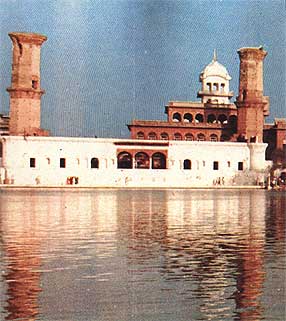
The
Ramgarhia Bunga
The history of the Bunga (Punjabi word for quarters) is inseparable from the history of the Golden Temple because its very existence is dependent on the latter. During the reign of the Mughal Emperors the temple was blown up with gunpowder or destroyed by other means no less then seven times. But each time it was rebuilt by the Sikhs. When it was demolished the last time, and the Sardars of the 12 Misl assembled at the Akal Bunga (situated in the front of the temple) to consult about the reconstruction of the fane (temple) it was rightly thought that it would be no use to rebuild the temple unless some of the Khalsa leaders remained in it for its protection against their enemies. The Bhangi's, the Ahluwalia's and the Ramgarhia's were selected to dwell in the sacred precincts with their forces as the guardians of the temple. They were directed to call the other Sardars for help in case of any great danger, each of the six great Misls gave also one man to serve the temple. The present Pujaris are descendants of those six men. The income of the temple after deducting other expenses is divided and sub divided, and distributed in due proportion among the descendants of the six Pujaris. The Pujaris had some fixed duty to perform and were called according to their duties, e.g., the man who lighted the lamp was called charagi (charag, lamp in Punjabi) and so on. Their descendants still retain the old designations. The duty of the person given by the Ramgarhia Misl was to perform the ardaas (offering ceremony), his descendants are also called ardasias. The ceremony is thus performed, the ardasia stands respectfully with his face to the Granth and distinctly repeats the name of the ten Gurus in the prescribed manner and then says that such a person has brought such and such a thing as an offer to the Guru, may the Guru purify his soul and grant his prayer.
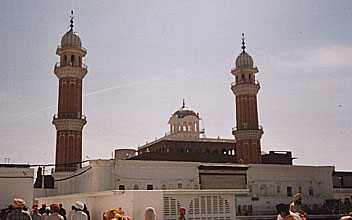
The present day picture of the Ramgarhia Bunga
with a plaque underneath (below)
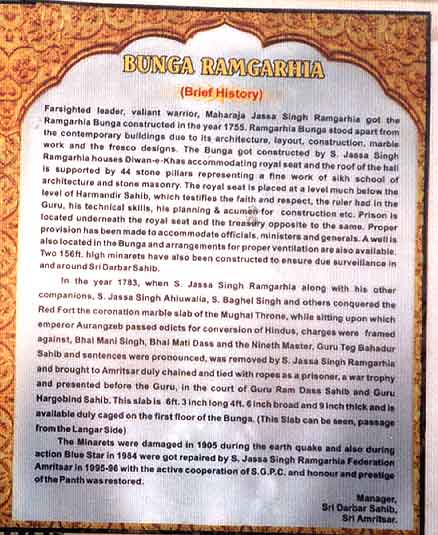
The Bhangis built two forts, one called fort Bhangian to the south and the other called fort Gujar Singh to the west of the temple. They also built a Bunga to the west of the temple. The Ahluwalias built one fort called the Ahluwalia fort for their army and one Bunga called the Ahluwalia Bunga for their own residence both to the north of the temple.
The Ramgarhias, likewise, rebuilt the old fort Ram Rouni for their forces and named it Ramgarh. They also built a Bunga called Ramgarhia Bunga for their own residence to the east of the temple. Thus the temple was protected on all four sides by these Sikh Sardars. The very structure of this Bunga shows the special purpose for which it was built. The two lofty towers were obviously built to espy the enemy from a distance. The Bunga is the largest of all the mansions. The towers are each three storied and nearly 156 ft. high from the ground. No wood is used anywhere in the construction. Besides numerous masonry arches, there are 44 marble and red stone pillars (very beautifully ornamented with engraved designs) supporting the roof of the upper storey of the Bunga. The front part is highly decorated with delicately chiselled patterns of unrivalled excellence. Here the ancient Coronation Stone of the Grand Mughals (which Sardar Jassa Singh brought from Delhi) is fixed, having three pillars on each side, the priest every day recites the holy Granth on this historic slab. The dimensions of the stone are 6'-3" X 4'-6" X 9." The length of the frontage of the Bunga is nearly 150 ft. One can have a very good view of the city from the storeys of the towers, many European visitors come to enjoy the sight and many take photographs of the extensive view below their feet. These towers are visible from many miles, and add to the beauty of the city. When Maharaja Ranjit Singh took possession of the territory of the Misl, the Bunga also went to him. The Bunga for some reason or others was only half finished and the towers were not yet domed, because it was the intention of the Sardars to raise them higher. But Ranjit Singh at once ordered that the towers be raised no higher and all the materials and many pillars and pieces of stone and marble very beautifully engraved he sent to Ram Bag (now called Company Gardens) which he was preparing as a pleasure ground. There was such a large stock of building material that after using all that was required for the garden the remainder were stocked and employed afterwards in the preparation of the last bed for the Lion of the Punjab in the Guru Garden where free from the anxieties of the world he sleeps calmly and quietly under the serene shadow of the lofty Ramgarhia towers. By comparison also many of these pieces are found of the same pattern and sculptured by the same hand. Afterwards the Bunga was given to Sardar Mangal Singh Ramgarhia for his personal services by the Maharaja and from that time the Bunga became the property of Sardar Mangal Singh alone. Since that time the Bunga is used as a place of residence by the male members of the family. There is built a large house, 3 storied and 140 ft. long for the female members of the family in the Katran Ramgarhian. The street in which this house is built is called Koocha Sardar Mangal Singh Ramgarhia and a board is set up there by the Municipality which the above inscription. The fact that the family has fixed its abode in the proximity of the Bunga with temple is one of the chief causes that enabled the members of this family to manage the affairs of the Golden Temple so well. This family has been connected with the temple from the very beginning, and thus its members know the whole process of its evolution, and the principles required to manage its affairs. The members of this family, besides, consider it a religious duty to look after the shrine. Aye, for this temple their ancestors gladly risked and laid down their lives. It is for these reasons that Sardar Mangal Singh was appointed the President of the managing committee of the temple consisting of all the Sikh Sardars of the Punjab.
There is a celebrated temple called Hazur Sahib situated in Dakhan in the state of His Highness the Nizam of Hydrabad. Round that temple also there are Bungas built by the Sikh Sardars. The Ramgarhias also built a Bunga there, which exists to this day and is grander than all Bungas and is also called Bungan Ramgarhian
Katra Ramgarhian
The Ramgarhian Katra (Bazar) was the natural adjunct of the Ramgarhia fort, which has been stated, was the chief seat of the family, and the head quarters of the Ramgarhia army, numbering thousands. The Bazaar arose on the space between the Ramgarh fort and the Bunga in the environs of the temple, and named Ramgarhian Katra. In the same way the Ahluwalia built a Bazaar between their fort and the temple and named it Katra Ahluwalian. The Ramgarhian Katra is the greatest of all the Katras and covers over an area extending over 3 gates of the city. This is one more proof of the fact that the Ramgarhia forces appointed to guard the temple were more numerous than those of any other Misl. This Katra constitutes one fourth of the city. It is till known by that old name and the signboards with the inscription (Katra Ramgarhian) are put up by the Municipality on its boundaries. In this way the memory of this great house is kept to this day.
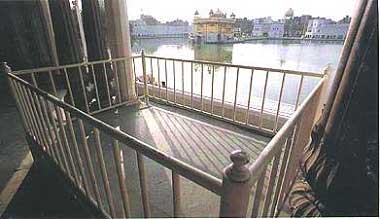
The view of Harmandir Sahib from the Ramgarhia Bunga. The 'sill' (coronation stone used by the Mughal Emperors) can be seen in the forefront, which was brought by Maharaja Jassa Singh Ramgarhia after the conquest of the Red Fort Delhi.
Tarkhan
This article is about Tarkhan, a Northern Indian tribe.
The Tarkhan ethnic tribe inhabits the Punjab area of Northern India and Punjab area of Pakistan. Scholars such as H.A. Rose state that they are descended from the Saka tribes, and originally settled in Taxila. They are known to be of the same stock as the Jatt ethnic tribe & other tribes as they are a purely a Indo-Scythian tribe. Moreover, it is interesting to note that Tarkhan was a title used by some of the known armies that invaded India during the reign of Tamer the Lame of Central Asia, therefore it is possible that the Tarkhans found in Punjab and the Northwestern Province are actually the descendants of those Tarkhans.
History oF Tarkhans
Sikh Tarkhans are more commonly known as Ramgarhias because of their reverence for the famous Misl leader, Jassa Singh Ramgarhia (1723-1803), who was a Tarkhan.
A very proud and fiercely independent people, they are amongst the wealthiest and most educated clans of India. Historically, the Sikh tarkhans' occupation was Carpentry.
Tarkhans have served couragously in crack Commando units of the Punjab and Sikh Regiments of the Indian Army, as well as brave fighter pilots and in the Navy. They were made famous on the silver screen in the Bollywood film, Border for their brave actions in the Battle of Longowal, a battle fought during the Indo-Pakistani War of 1971.
Races designated by the British as martial races
"Rajputs" (anonymous, c.1860) From the collection of the British Library.British declared martial races [15][page # needed] (listed below in alphabetical order):
Awans Bhumihar Cheema Dogra Garhwalis Gujjars Gurkhas Irish Jats Javanese Kamboj Kumaoni Minhas Mohyal Scottish Sikhs Tarkhan (Punjab) Pashtuns/Pathans Rajputs Tyagis Yadavas Zulus
Clans In Tarkhans
A
* Ahdi
* Arrii
* Assi
B
* Babra
* Bachu
* Bansal
* Bahra
* Bamrah
* Bara
* Barhey
* Bassan
* Bari
* Baharha
* Bhachu
* Bhachoo
* Bhamber
* Bhambher
* Bhambra
* Bhamra
* Bhara
* Bharaj
* Bhari
* Bhatti
* Bheley
* Bhogal
* Bhui
* Bhurjee
* Bhurji
* Bilkhu
* Birmi
* Birdee
* Birdi
* Bubbra
* Budhoo
* Burmy
C
* Caveeshar
* Chaddha
* Chaggar
* Chamak
* Chana
* Channa
* Chani
* Channy
* Chharote
* Chita
* Chodha
D
* Daddoo
* Dadiala
* Daffu
* Dahale
* Dahley
* Daphu
* Darhalay
* Deerhe
* Deogan
* Deogun
* Deosi
* Devgan
* Devgun
* Devsi
* Dhaffu
* Dhammi
* Dhamu
* Dhanni
* Dhanjal
* Dheeraj
* Dhiman
* Dhonsi
* Dhoopar
D..
* Dhulphir
* Dhuphar
* Dogra
* Dulphir
* Duphar
F
* Flore
G
* Gabri
* Gabriah
* Gahir
* Gaidu
* Gallad
* Gaand
* Gansie
* Gargaj
* Ghariall
* Gharyal
* Ghatora
* Ghattora
* Ghir
* Ghura
* Gidda
* Gilla
* Gillar
H
* Harbias
* Hothi
* Hunjan
* Hunjoon
* Hunzan
* Hussainpura
* Hussainpuri
* H...
* Hussanpura
* Hussanpuri
* Hyothi
J
* Jabba
* Jagdeo
* Jagdey
* Jandu
* Jandoo
* Jass
* Jetlay
* Jhass
* Jhita
* Jhooti
* Jouble
* Jutla
* Juttla
* Jutley
K
* Kaile
* Kainthal
* Kalsi
* Kaundal
* Khalsi
* Kharal
* Kharey
* Kharl
* Khattia
* Khohar
* Khokhar
* Khural
* Kohar
* Kular
* Kundral
* Kundi
L
* Lall
* Lafunghaa
* Leel
* Lota
* Lotay
* Lottay :D
* Lyall
M
* Main
* Mandaley
* Mankoo
* Manku
* Marway
* Marwa
* Marwaha
* Matharoo
* Matharu
* Matyar
* Meen
* Mion
* Mudarh
* Mudhan
* Mudhar
* Multani
* Mundae
* Munday
* Muttair
N
* Nadoia
* Nagi
* Nandhra
* Nandra
* Nanery
* Nanre
* N...
* Nanra
* Nautay
* Nawetay
* Notah
* Notay
* Note
* Notta
O
* Obhi
* Oshan
P
* Padam
* Palhora
* Palne
* Panesar
* Philoura
* Phloray
* Phull
* Phul
* Plaha
* Plania
* Pohli
* Puaar
R
* Ramgarhia
* Ranauta
* Rayat
* Rehal
* Rehnsi
* Riat
* Rihal
* Riyat
* Rooprai
* Rupal
* Roopra
* Ruprah
S
* Sagoo
* Saggu
* Sagu
* Salh
* Sambhi
* Sandhu
* Saond
* Saund
* Sayan
* Seehra
* Sehmi
* Sehra
* Sembhi
* Seol
* Shergi
* Sihota
* Sihra
* Sian
* Singhraj
* Singhpal
* Sira
* Sokhi
* Sohal
* Sohanpal
* Sond
* Sondh
* Soor
* Soora
* Sootdhar
* Spal
* Sund
* Sura
* Suraj
* Surajbansi
S...
* Suri
* Sutardhar
* Syan
* Singhrao
T
* Tattar
* Tethi
* Thoka
U
* Ubhi
V
* Verdi
* Virdee
* Virdi
* Virdy
Z
* Zandy
(article sent by courtesy of Pali Sehmi )
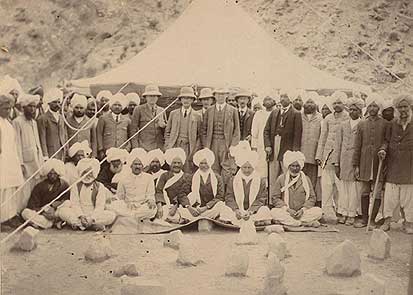
The article Annals of Ramgarhia Sardars was written by S. Sunder Singh (direct descendent of Maharaja Jassa Singh)seen here circled. This historic photo was taken on the 19th march 1913 somewhere in Punjab during a visit by Sir Luis dane at a Dam Site, where S. Sunder Singh was one of the main architects and engineer of the project.
Some paintings relating to Maharaja Jassa Singh Ramgarhia
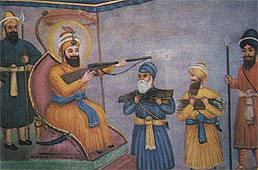
Father of Maharaja Jassa Singh, Bhai Bhagwan Singh and grandfather Baba Hardas Singh presenting guns and arrows made by them to Guru Gobind Singh Ji.
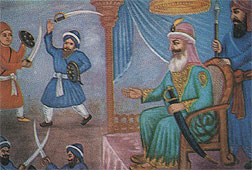
Maharaja Jassa Singh teaching his sons the art of sword fighting
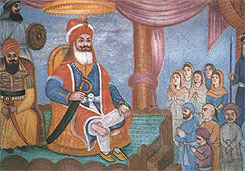
After saving the hindu girls from the clutches of the Muslims, Maharaja Jassa Singh returning them to their parents. Hence he was called 'Bandi Chhod'
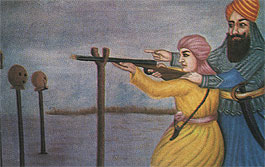
Maharaja Jassa Singh training his son Jodh Singh on the use of the rifle
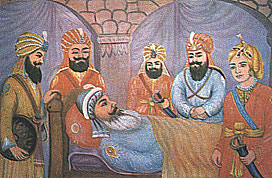
Maharaja Jassa Singh on his death bed surrounded by his brothers Alli Singh, Malli Singh, Tara Singh and his son Jodh Singh
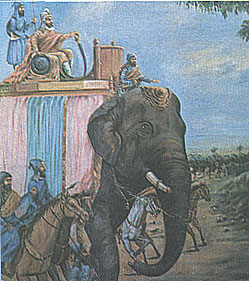
Maharaja Jassa Singh atop an elephant with his generals
